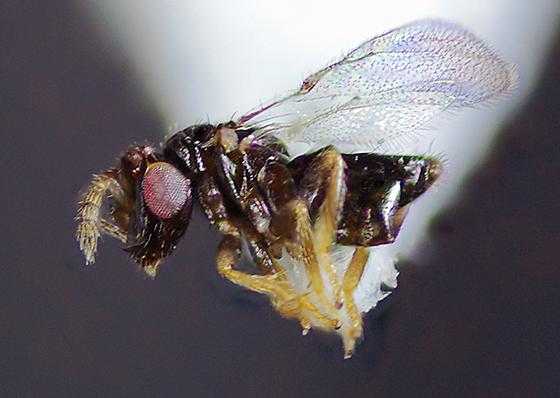MĀNOA, Hawaiʻi – In the coming months, Hawaiʻi coffee growers will have their very own tiny version of Marvel’s superhero, Wasp. Virtually invisible to the naked eye, Phymastichus coffea (P. coffea), a minute parasitic wasp, targets the coffee berry borer (CBB), which causes severe yield losses in coffee-growing regions world-wide.
Researchers in the University of Hawaiʻi at Mānoa College of Tropical Agriculture and Human Resources’ Department of Plant and Environmental Protection Sciences (PEPS) and USDA-ARS (Agricultural Research Service) plan to deploy thousands of these wasps in coffee-growing areas on Hawaiʻi Island and possibly Maui and Oʻahu.
“This biological control agent has the potential to make significant positive economic impacts in the Hawaiʻi coffee industry, and offers an environmentally safe way to manage CBB,” said Professor and Extension Entomologist Mark Wright.
“The Hawaiʻi coffee industry is economically and culturally significant, and we hope that this work will improve the lives of many people associated with the industry.”
An inside agent
P. coffea is a parasitoid. Unlike parasites that live and feed on a living host organism, this insect’s larvae will eventually kill their hosts. When CBB pests dig into live fruit, such as coffee beans, they release chemicals that attract the wasp. As a biological control agent, it has been used successfully for a number of years in Central and South America, especially Colombia.
Starting in 2018, live shipments of the wasp were allowed to come into Hawaiʻi under strict quarantine for research— specifically for testing on native insects similar to CBB, such as those in the same subfamily as CBB, to assure that no unintended impacts on native species are likely to occur, as well as other non-native invasive species in the same genus as CBB.
Since then, Wright and PEPS graduate students David Honsberger and Luis Aristizabal, along with Marisa Wall and Peter Follett from the Daniel K. Inouye U.S. Pacific Basin Agricultural Research Center, have been inching closer and closer to their ultimate goal: releasing thousands of these wasps into coffee-growing regions in the state where CBB has ravaged farms.
“CBB arrived in Hawaiʻi without the natural enemies that keep populations in check in its native range in Africa,” said Follett. “The introduction of the African parasitoid wasp Phymastichus coffea will reunite CBB with its most significant natural enemy from home. Releases of this wasp in coffee in Colombia against CBB have been shown to limit populations to subeconomic levels.”
Unleash the wasps
With approval from the federal Animal and Plant Health Inspection Service and permit from Hawaiʻi Department of Agriculture to bring consignments of P. coffea over from Colombia, the current plan is to hold and breed the wasps in quarantine for at least two generations to ensure they are a pure colony with no contaminants or diseases. Then, PEPS and ARS will mass produce the wasps and release them into the field.
Wright said that the wasps will fly free, hopefully become permanently established in release locations, then distribute further throughout coffee growing areas in the state. They will likely be released first in the Kaʻū area of Hawaiʻi Island, then possibly expand to Kona, the Waialua area of Oʻahu and Maui.
“If all goes according to plan, it’ll make a massive impact,” said Wright.


















